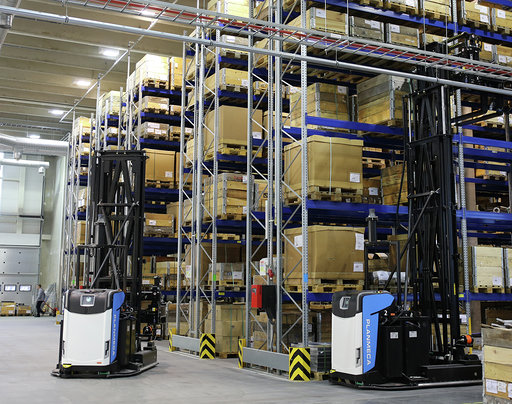 Rocla AGV reachstacker |
Warehouse automation is undergoing rapid change and expansion. Melissa Barnett looks at the challenges ahead for the market sector, solutions and how the current situation is impacting on business.
According to a recent study by
LogisticsIQ, the warehouse automation market is set to reach USD27 billion by 2025. The report proposes that the main drivers behind the increase are a rise in e-commerce and the challenge of sourcing skilled labour. The impact of the COVID-19 pandemic across the world have significantly and unexpectedly affected both the labour force and e-commerce operations.
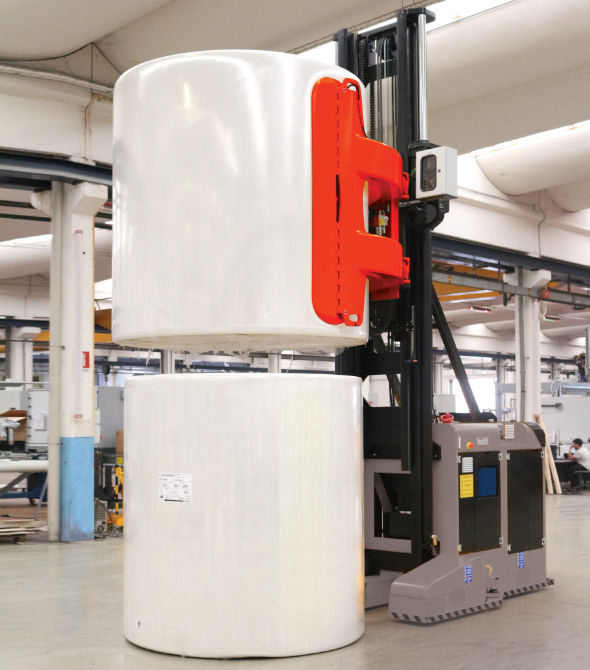 Bolzoni paper clamp for AGV |
"We believe that automation in materials handling and warehousing will become more important in the near future. COVID-19 can only speed up this process, as production and warehousing processes can benefit from automation in terms of health, safety and social distancing," says Carlo Fallarini, global marketing director for Bolzoni Auramo.
Logistics has been regarded as an essential service across the world during this crisis and, as Brian Markison , Unicarriers Americas,senior director for AGV sales and industry partner, Oskari Lindstedt, sales director Americas, for Rocla AGV Solutions observe, "The current situation, of course, causes delays in the short term, including (to) AGV projects, but logistics is an essential business (and) we need to ensure at this time that our automated systems keep running and materials keep moving, especially in the healthcare and food and beverage industry. We are confident that the role of automation in materials handling will continue to grow in the coming years, with COVID-19 perhaps creating a new 'normal', where companies seek automated solutions to reduce human contact with products in the supply chain."
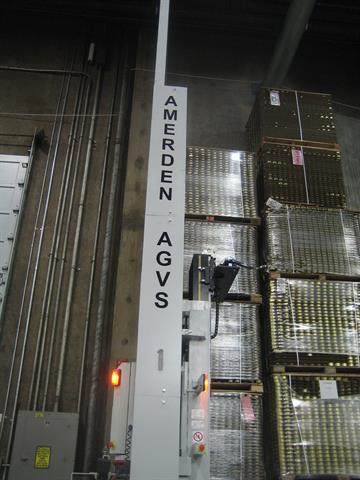 Amerden AGVS double stacker AGV with gripper |
Roland Anderson, president of AGV manufacturer Amerden, believes that the current crisis has made people think about their futures which may affect the post-COVID-19 labour market. "I believe older people who can afford it will be looking to retire, now they have tasted 'free' time and the younger people may change jobs or go back to school and look for more rewarding jobs," he says. In the meantime, Anderson says his customers are benefitting from being automated: "Even if shipping and receiving are down, warehouses can be re-organised and improved easily using AGVs. Essential manufacturing plants using AGVs have not seen many changes; for many, it is business as usual," he says.
A crisis can highlight areas in a business that can be improved. Carlos Millan, manager of business development for AGVs at Oceaneering-America, believes that the pandemic has identified gaps that automation could help fill and he believes it has propelled some organisations to begin planning for future automation to mitigate the risks that recently surfaced, such as labour shortages. Millan foresees the industry growing at a faster rate as a consequence.
John Coppus, OEM manager at Cascade Corporation, agrees, "The COVID-19 pandemic is a catalyst in what was already a trend towards warehousing and logistics automation. The overall impact will be a significant acceleration of automation, perhaps sooner that has been forecast," he predicts.
Decision time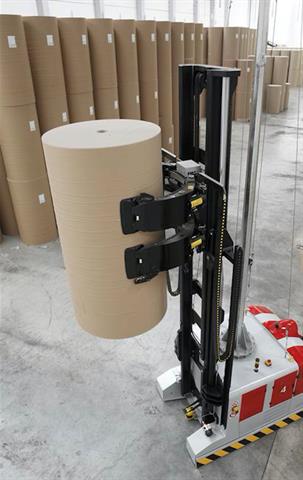 Cascade clamp on a warehouse AGV |
This global crisis has also highlighted the world's dependence on a steady and reliable flow of goods from manufacturer to retailer and customer. It seems inevitable that automation will fulfill the demand. Coppus explains: "With increasing e-commerce activity, especially at this time, we are seeing how systems and businesses respond to increased demand and ways materials handling can help. New workplace precautionary norms of social distancing, sanitation and more will only add to the need for supply chain automation in warehouses. With fewer people allowed in close proximity, automation is inevitable to keep pace with the rise of e-commerce." Coppus believes that by 2025, the industry will see both large and small operations combining automation technology along with skilled labour in order to enhance health and safety efforts while also minimising costs and increasing throughput.
Kang Long, deputy general manager for Hangcha AGV, says that the price gap between manual forklifts and automated ones is getting smaller; therefore, price difference is no longer influencing decisions and there are more pressing considerations for adopting automation. "The increasing labour cost has become the major expense for a company and, in fact, is much more than is spent on investment on AGVs and the follow-up maintenance costs. Automated logistics has broad market prospects, which can be seen from the increasing sales volume in recent years," say Long.
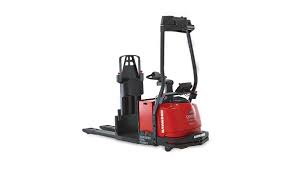 Raymond Courier AGV 3010 pallet truck |
Before any investment is made, however, it is important to consider automated solutions offering flexibility and scalability for future growth, advises Tiger Xu, product manager, automated solutions for the Raymond Corporation. "Before getting too invested, optimisation is a crucial step that must be based upon lean process analysis," says Xu.
Millan agrees and adds that there are some specific things a business wishing to scale up to automation should consider, including identifying gaps in production or material process, developing a plan on how to mitigate the current state and create a new norm by implementing or adding automation capabilities and, most importantly, asking the hard questions of your potential partner.
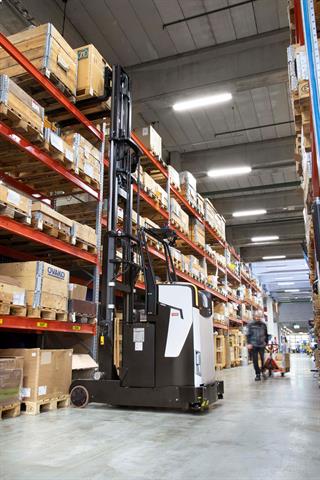 Rocla ART narrow aisle AGV |
Start initial automation projects on well-defined workflows and work with the solution provider using simulations to select the appropriate process, advise Markison and Lindstedt. "For example, Unicarrier's AGV equipment is based on modular structure, giving the ability to offer solutions to a wide variety of applications, by still using standard components that enable simple and straightforward service throughout the system's lifetime," says Lindstedt.
What's next As the world of forklifts and AGV merge, the challenge for AGVs is to become as adaptable as their manual counterparts. In the world of e-commerce, the size, shape and type of goods is changing, with goods becoming heavier, larger and bulkier. Meanwhile, outside the warehouse, traditional materials handling equipment like container handlers are also moving towards automation. "Traditional forklift sectors are slowly becoming more and more automated, and container handling is a good example. Amerden has regular inquiries for AGVs moving truck trailers in yards and they are common in heavy industries such as Aluminium plants," says Anderson.
Fallarini says that he would split future opportunities into two segments: logistics and production process. Heavy industry, particularly the paper and car industries, is looking more into automated systems, but the growth market is in narrow-aisle machines for warehouse automation. "Bolzoni Auramo has AGVs working from the raw material inbound to the lorry loading activity in the external yards. Our AGV-dedicated product range includes rotating clamps to support manufacturing operations and big paper roll clamps to handle huge tissue rolls in paper mills. The Bolzoni Auramo narrow-aisle machines have been developed with an electric-driven trilateral head able to rotate a complete 180-degree rotation inside the aisle width.
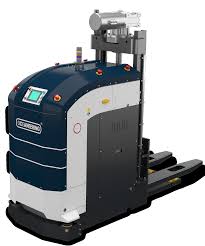 Oceaneering MaxMover AGV |
The continuing challenge, says Millan, is to develop the perfect method to move large irregular items around areas with limited space. "Currently, Oceaneering AGVs can handle material up to 1,250 kg, but we have been developing an automatic guided forklift for outdoor use with a lifting capacity of up to 3,600 kg which we plan to demonstrate later in the year. It is a forklift that can be used indoors as well (and) the application will solve the need for automation in outdoor facilities," says Millan. Automation, he says, is already moving into tradition manual forklift areas including mining and will continue to make forays into vertical industries, such brick, stone, tile and metal yards. These smaller outdoor applications will find a huge benefit in deploying outdoor AGVs, he believes.
Long says that AGV manufacturing needs to adapt to different types of commodities by combining the non-standard customisation of AGVs with visual recognition, weighing systems and super-wide detection. "At present, the application of AGVs are mostly limited to indoor environments. In the future, Hangcha will introduce outdoor navigation systems and other chassis controls to replace manual forklifts," he says.
The growing availability of AGVs is introducing opportunities not only in warehousing and logistics, but in virtually any application. Coppus says, "At Cascade Corporation, we are seeing an increase of automated capabilities for telehandlers and similar worksite vehicles. Various load sizes provide an opportunity for digital integrations into the forks or attachments for AGVs. For example, our mobile weighing solutions have the ability to automatically capture and track essential data. These systems as well as Cascades sensor package and wireless cameras can be embedded at the tip of the fork and integrated into AGVs throughout the supply chain. "Some industries present unique challenges, such as construction environments that have unpredictable conditions and these may be applications best solved by human operators, but as long as automated solutions continue to provide value to customers, there is no doubt they will continue to be adapted."
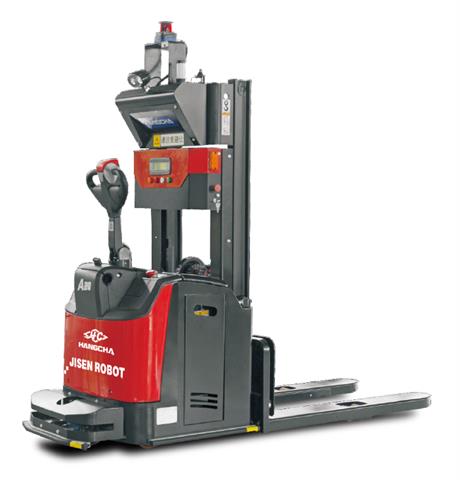 Hangcha 2t AGV stacker |
The last word on the future of the AGV market goes to Long: "With the improvement of living standards, (it is more difficult) for the existing labour source ... to meet current market and production demand. It has become a trend to replace manual work with automated equipment such as AGVs and robots. Our needs for automated warehousing and production has become more urgent upon the outbreak of COVID-19. Automated warehousing is on its way and accelerating."
Additional information and a special 'THANK YOU' to our contributors:New Perspectives on Materials Handling with Cascade Sensor Forks
Cascade Corporation: website------------------------------------
Easy-MOVE: Damage Free White Goods Handling with BOLZONI AURAMO
Bolzoni Auramo: website------------------------------------
Less Emission and More Power - Hangcha EU V Engine Products Are Ready
Hangcha: website------------------------------------
Amerden: website------------------------------------
Oceaneering: website------------------------------------
Raymond Corporation: website------------------------------------
Unicarriers America Corporation: website